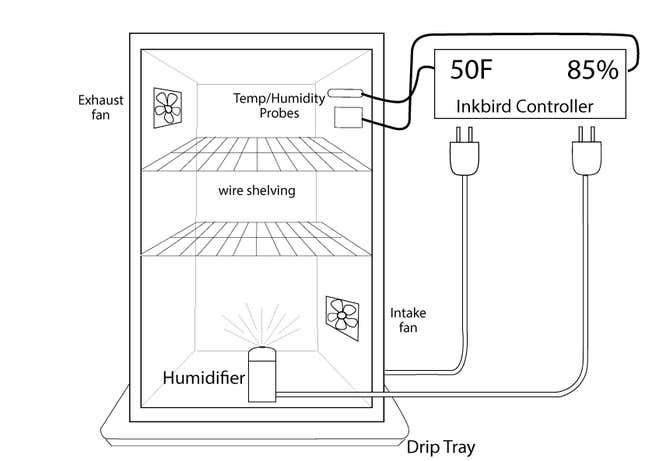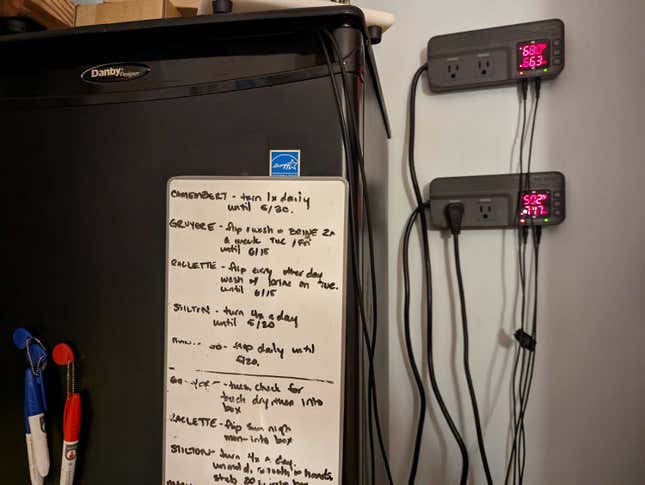How to Turn a Mini Fridge Into a Cheese Cave
I learned to make cheese under the tutelage of two women on a farm in New Zealand. The memory that really stuck is being shown to the cheese cave, a walk-in outbuilding protected by the largest duck I’d ever...

I learned to make cheese under the tutelage of two women on a farm in New Zealand. The memory that really stuck is being shown to the cheese cave, a walk-in outbuilding protected by the largest duck I’d ever laid eyes on. As if to explain his largesse, the cheesemaker noted “we throw him a lot of curd.”
I do not have a duck watchman, but I do have a cheese cave. When my cheesemaking hobby really started to ratchet up, having a place to age and store them became necessary. They’re not hard to make, you just need to find the parts.

Camemberts fresh out of the cave. Photo: Amanda Blum
What you need to know about cheese caves
Cheese caves do two things: help cheese mature by creating an environment perfect for growing mold, and keeping your cheese away from anything that might have mold we don’t want to grow. If you are very enthusiastic about cheese but not planning to make cheese yourself, you can simply utilize your refrigerator, which usually has drawers that can maintain higher humidity, since you’re buying already matured cheese.
A cave maintains a specific temperature and humidity. That temp and humidity need may change slightly, depending on the specific cheese you’re making, but they all hang out in the same rough band: around 50℉ and 80% humidity. Your average fridge is set to be a much lower temperature with much less humidity—35-40℉ and 65% humidity—so we’re a far ways off using standard settings.
You’ll need space in your cave; you want room for air to circulate around your cheese. Soft cheeses may be as small as three to six inches, or if you’re making hard cheese, they can be as big as eight to 10 inches. You’ll also need a way for fresh air to come in, although opening the closing the door is often good enough.
You’ll want shelves for your cheese to rest on, and most fridge shelves aren’t appropriate, because they’re glass. We need air to circulate around the cheese, so wire shelves are great, and in some cases, wood can be used.
The Container
With modifications, fridges make excellent cheese caves, and they’re what most hobbyists use as their base. They’re really well insulated, and have the ability to cool, and are basically a big box.

Illustration: Amanda Blum
You can start with any working fridge, and some people go big, but for your first foray, I recommend a mini fridge or wine fridge. Most people start with a used appliance. The real advantage to a wine fridge is that they often control humidity and temperature, so you don’t need to do much more, which is a real bonus.
If not, you’re looking for a mini fridge without a freezer. This is pretty important, because a freezer will affect the temperature and humidity of the fridge, and you usually can’t remove them without destroying the coolant features. The goal is securing a single, empty box. At the time that I built mine, everyone was chasing a Danby, because they tended to fit the parameters. You’ll be competing with folks trying to build beer fridges, because they have some of the same needs.
Start in all the places you’d look for anything secondhand: Craigslist, Facebook Marketplace, BuyNothing, Nextdoor, even Reddit or OfferUp. It may take a while to source one.
Once you get the fridge in your hot little hands, the most important step is to scour it like your life depends on it. You’re going to be creating a very mold friendly environment, but we want to control the kind of mold, and that starting with a spotless environment. Use bleach and get into all the nooks and crannies.
Next, you’ll need to remove the shelves, both from the fridge and the door, and any baskets. These usually come off pretty easily. You won’t need them, so they can get repurposed. The fridge should now be completely empty.
We’re going to slide in wire racks in place of the shelves; you just need to find a rack the right size on Amazon. It’s usually pretty easy to do so. You can also use a really strong adhesive and some furring strips to create a rest for shelves.

My cheese cave stack, with a reminder board of what’s inside. The Inkbird controllers show the temp and humidity in my caves. Photo: Amanda Blum
Controlling the Temperature
A refrigerator works by kicking on when the temperature hits a high-ish temperature. It cools the interior back down to a specific set temperature, then switches off. We just need to change that temperature, and the way to do it is with an Inkbird controller. Plug the fridge into the Inkbird controller, and set the temperature to 50℉. The controller will tell the fridge when to kick on and off. I highly advise watching the videos on how to set up the Inkbird.
The probes for the Inkbird are small, and can be taped to the wall and then run out the door. You don’t need a hole for this, the wire is small enough that the rubber gasket on the fridge will seal around it.
Controlling the Humidity
The Inkbird controller will also monitor and control humidity, but since the refrigerator doesn’t have a device to create humidity, you’ll need to make one. People generally use small cold mist humidifiers for this, and you’d plug those into the controller. You need to find one that doesn’t require you to punch a button to turn it on; it should switch on once it’s connected to a power supply. Now, these misters need to be refilled with water pretty regularly, but that’s ok, because you’re going to be checking on those cheeses daily.
You may be tempted to “hack” this by hanging wet towels in the fridge. Don’t do that. Again, we’re doing everything we can to encourage good mold, but as anyone with a lazy teen will tell you, damp towels also create bad mold.
Adding Fresh Air
Opening the door of your (small) fridge daily generally provides enough fresh air exchange. But as you go larger, or if you want a more controlled environment, you can add a computer fan to a hole in the side and plug it in, and you’ll have fresh air all the time. You’ll want one for intake and one for exhaust, so you get a cross-breeze. Get the smallest fans you can, and keep them on the lowest setting possible. They will cause the air to circulate, although your humidifier will cycle on more.
Keeping the floor safe
I put set my cave on a liner, because all that humidity has to go somewhere, and I’d rather it not be my floors.
Other than that, you’re all set. Now that you have your cheese cave, you can place all your cheese in it, not just the cheese you make yourself. But you really should start making cheese yourself. It’s wildly rewarding.

 Kass
Kass 
































